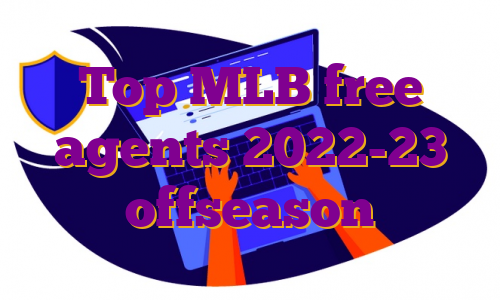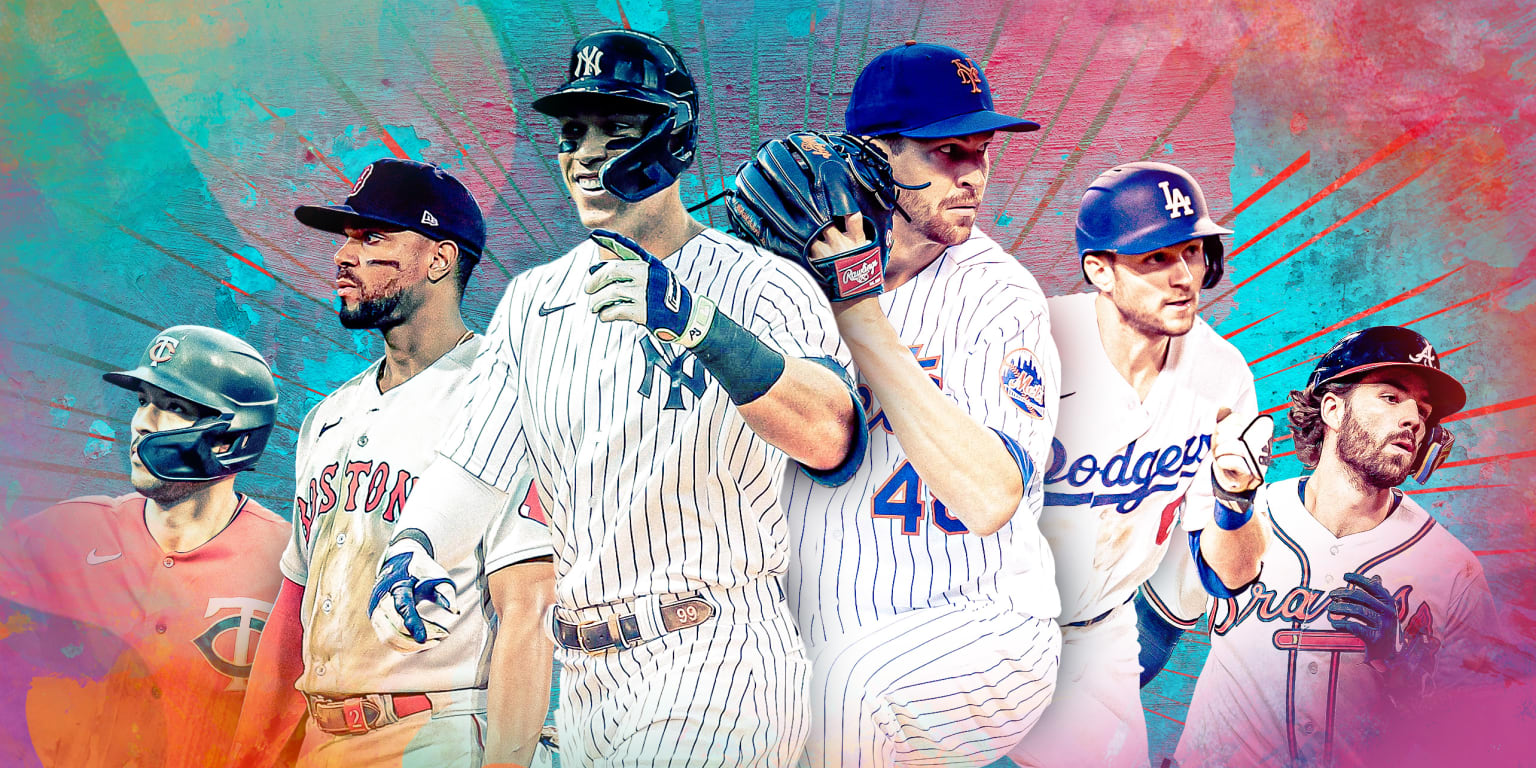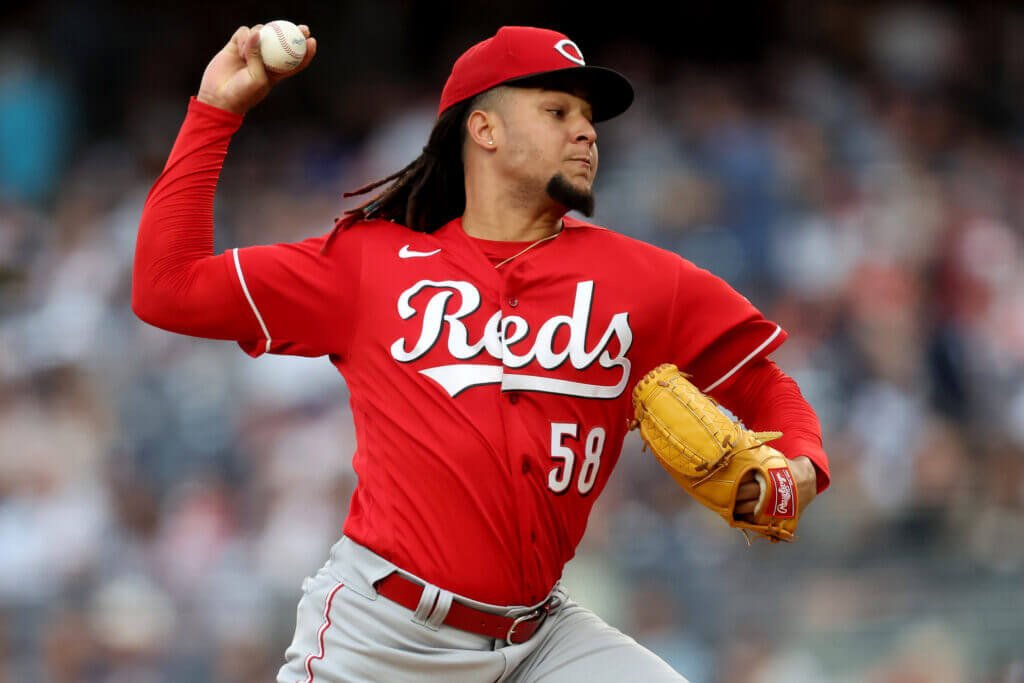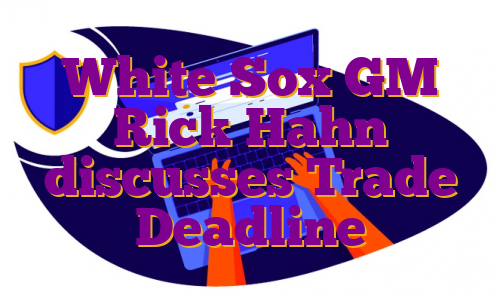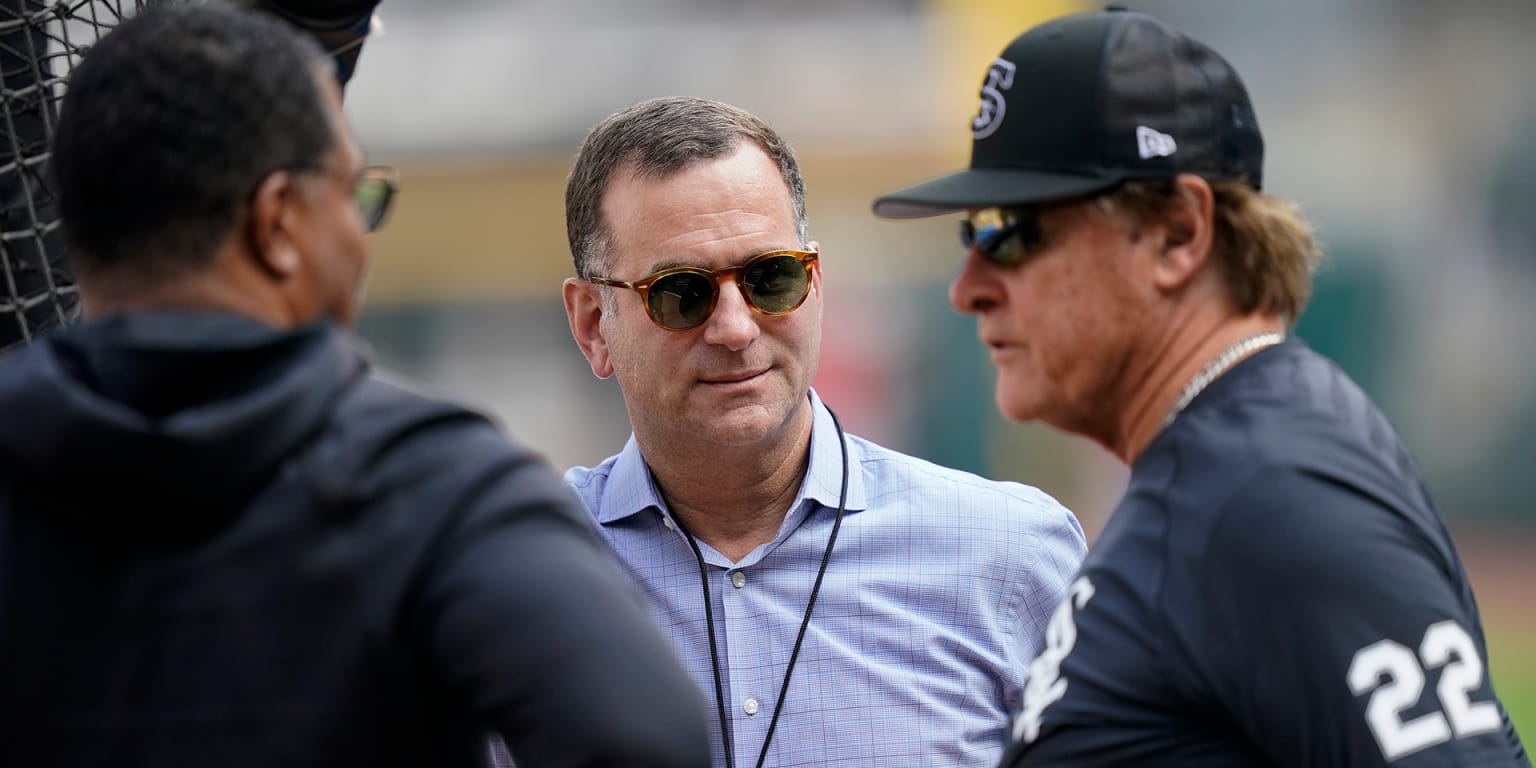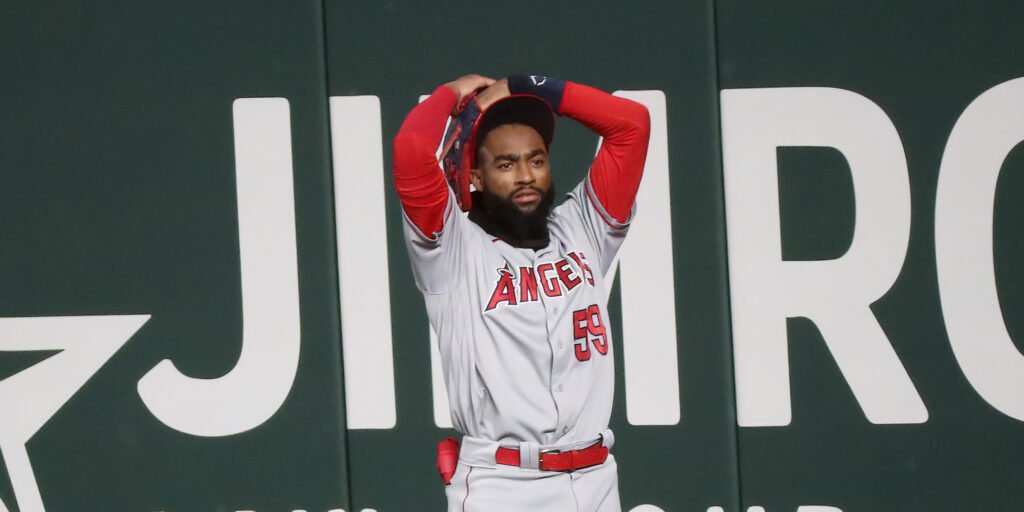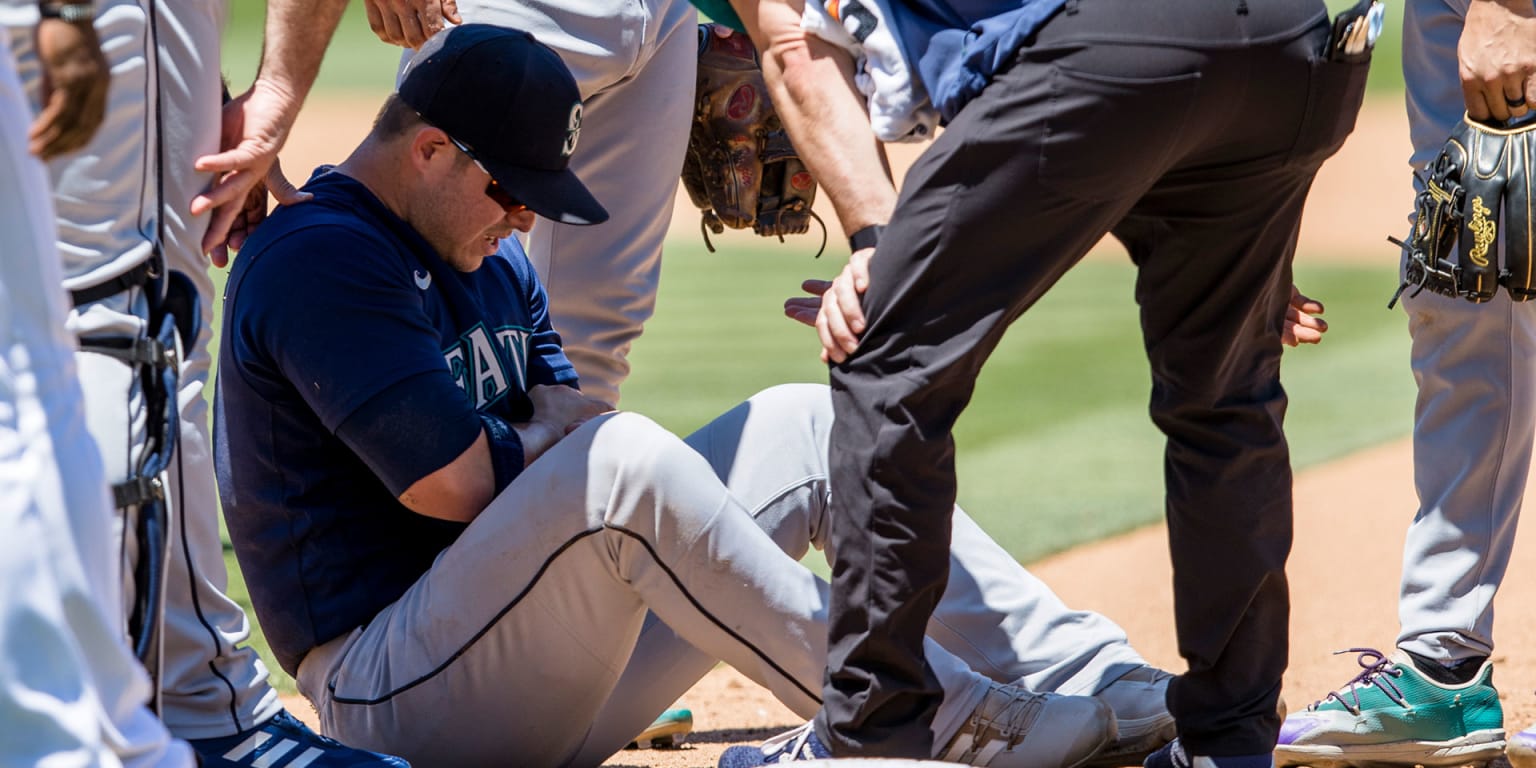A slew of short-term deals and player opt-outs makes for some deep waters in this winter’s free-agent pool. From the MVP-caliber bats to the starting pitchers likely bound for Cooperstown to the second smorgasbord of stud shortstops in as many years to an intriguing Japanese pitcher and plenty of other impact players around the diamond, there’s a lot to work with on the free-agent front.
Here’s a look at the top 20 players who could be available (pending opt-out decisions that must be made shortly after the conclusion of the World Series). The ages listed are the players’ season ages for 2023 (i.e., the age they will be as of June 30, or roughly midseason).
1. Aaron Judge, OF, Yankees, age 31
Have yourself a walk year, sir. When Judge turned down the Yankees’ seven-year, $213.5 million extension offer at the start of the season, it was an enormous bet on himself, given his age and injury history. But Judge went on to have an enormous, history-making year. What he did at the plate was astounding. But the 6-foot-7, 282-pound Judge was also serviceable in center field and adept on the basepaths, which only adds to his allure. It will be fascinating to see how much the Yankees are willing to go above and beyond their initial offer if a bidding war breaks out with another club, such as Judge’s hometown(ish) San Francisco Giants.
2. Jacob deGrom, RHP, Mets, age 35
Can opt out of $32.5 million guarantee for 2023
Even after missing more than a calendar year because of elbow inflammation and a stress reaction in his shoulder, deGrom has made it clear he will opt out of his remaining deal and test the market. In proving, upon his early August return to the Mets’ rotation, that he remains an elite starting arm on a Hall of Fame trajectory, deGrom could challenge teammate Max Scherzer for the highest average annual value ever for a starter. What will be interesting to see is how far teams will go in terms of length of deal, given the aforementioned injury history.
3. Trea Turner, SS, Dodgers, age 30
The 2021-22 free-agent shortstop class was a doozy, and Turner fronts another very strong one this winter. Turner brings a beautiful blend of power, average, defensive capability at a premium position and game-changing wheels (100th percentile in sprint speed). His value could actually accelerate in the pitch-clock environment, with the addition of pickoff limits.
4. Nolan Arenado, 3B, Cardinals, age 32
Can opt out of five-year, $144 million guarantee
Arenado said earlier this year that he does not intend to opt out, and he could stick to that. But he’s posted the best season of his stellar career. One of the greatest defensive third basemen in history, Arenado also delivers a power bat that has squashed any questions about how Coors Field once aided his offense. The question is whether he will opt out, renegotiate with the Cards or test the open market.
5. Carlos Correa, SS, Twins, age 28
Can opt out of $35.1 million guarantee for 2023
Correa’s three-year pact with the Twins last winter (including $35.1 million player options for both 2023 and ’24) was a legit shock. Now, he has the option of seeking a longer deal in the open market this offseason or remaining with a Minnesota team for whom he quickly settled in as a valued leader. Correa had a solid year for the Twins, but his iffy injury history (and the wealth of available shortstop talent) clouded his market last year, and his defensive metrics regressed in 2022.
6. Xander Bogaerts, SS, Red Sox, age 30
Can opt out of three-year, $60 million guarantee
Bogaerts’ offensive ability is unquestioned. He has had at least a 128 OPS+ (or 28% better than league average) in each of the last five seasons, and he’s done it in a pressure-packed market. And with an 89th-percentile showing in Outs Above Average, there ought to be no question about his current capability at short, even if he might ultimately move elsewhere in the diamond by the end of a long-term deal.
7. Justin Verlander, RHP, Astros, age 40
Can opt out of $25 million guarantee for 2023
Apparently age ain’t nothing but a number for Verlander, who became the oldest starting pitcher to not only make a viable return from Tommy John but to do so at a Cy Young-caliber level. It was a stunning season even for somebody with a Cooperstown-worthy pedigree, and now we’ll see where it leads in terms of market value.
8. Dansby Swanson, SS, Braves, age 29
At a bare minimum, Swanson gives a team league-average offense and a dependable glove at a premium spot. But he is also capable of elite stretches at the plate, and, while other sabermetric sources did not think as highly of him, Outs Above Average rated him in the 100th percentile defensively this season. It will be interesting to see if his hometown Braves let his market linger, as it did for Freddie Freeman last winter.
9. Edwin Díaz, RHP, Mets, age 29
His Timmy Trumpet-aided entrance is reason enough to get excited about Díaz, but the stats are pretty good, too. After some initial awkwardness in his first season in Queens in 2019, Díaz settled into a strong tenure with the Mets in which he re-established himself as one of the best closers in the game, racking up K’s, limiting walks and long balls and closing out games in a big market.
10. Carlos Rodón, LHP, Giants, age 30
Can opt out of $22.5 million guarantee for 2023
Though he had a breakthrough 2021 season with the White Sox, Rodón’s earning power was limited by concerns about left shoulder soreness and fatigue that had limited him in the second half. But a terrific season with San Francisco could set him up for a bigger deal this time around. He has a wipeout fastball-slider combo.
11. Chris Bassitt, RHP, Mets, age 34
Though he was not the most heralded of the Mets’ starting pitching acquisitions prior to 2022, Bassitt proved to be every bit as reliable as he had been in Oakland, delivering a career high in innings and at times fronting a rotation temporarily robbed of Scherzer and deGrom. He would be an attractive option for teams that don’t want to break the bank for deGrom or Verlander.
12. Brandon Nimmo, CF, Mets, age 30
Speed, good defense, a bit of power and solid strikeout and walk rates will make Nimmo an attractive option for teams that aren’t in the Judge bidding. The only major knock on Nimmo has been health. But new training methods kept him on the field for more games than in any season since 2018. That will help his stock.
13. Koudai Senga, RHP, Fukuoka Softbank Hawks, age 30
Though it is not a guarantee that Senga will sign with an MLB team, he is expected to weigh offers from them this winter. And with a career 2.59 ERA and 1.11 WHIP (along with a fastball that has been clocked at 101.9 mph) in 11 seasons in Nippon Professional Baseball, he will be targeted by a wide number of teams in need of a starting boost.
14. Clayton Kershaw, LHP, Dodgers, age 35
We don’t know for sure that Kershaw will pitch in 2023. He’s had a Hall of Fame-worthy career, he’s dealt with chronic back issues and — much like the legendary Sandy Koufax, with whom he is often compared — he might not try to squeeze every last inning out of his arm. But even with his innings again limited in 2022, Kershaw showed he is still a master at his craft. And whether it’s re-signing (again) with the Dodgers or following the longtime industry speculation and pitching for the Rangers near his Dallas home, he would obviously draw interest.
15. Tyler Anderson, LHP, Dodgers, age 33
Anderson’s one-year deal with the Dodgers — coming off a 2021 season in which he posted a 4.53 ERA for the Mariners and Pirates — didn’t garner much attention. But as tends to be the case, the Dodgers got the best out of him. Coming off his highest innings total since 2018 and finding consistent success as a strike-thrower with an excellent changeup, Anderson looks to be a nice stabilizing rotation presence.
16. José Abreu, 1B, White Sox, age 36
A model of consistency since coming over from Cuba in 2014, Abreu has had only one full season in which his OPS was below .800 and he played fewer than 145 games (2018, when he won the AL Silver Slugger honor anyway). As was the case three years ago, the White Sox might value his leadership too much to let him get away.
17. Willson Contreras, C, Cubs, age 31
Concerns about Contreras’ defense limited his trade value, ultimately resulting in no deal at a Trade Deadline in which he had seemed an obvious candidate to move. Those same concerns could affect his free-agent market. But Contreras’ abnormal offensive production from the catching spot is difficult to ignore, and, if the Cubs don’t re-sign him, other teams could be interested in using him in a hybrid catching-DH role, as the Cubs did.
18. Josh Bell, 1B, Padres, age 30
Bell is an imposing, switch-hitting presence in a lineup but also an inconsistent one. His 2022 season, in which he slashed .311/.390/.504 in the first half before falling off in the second (amid a trade from Washington to San Diego) makes it difficult to read his market.
19. Nathan Eovaldi, RHP, Red Sox, age 33
Though Eovaldi was particularly homer-prone in 2022 and has had Tommy John twice, his raw stuff (including a fastball that averages 96 mph), the depth of his repertoire and his postseason pedigree make him worth including here.
20. Adam Wainwright, RHP, Cardinals, age 41
Teammates Albert Pujols and Yadi Molina announced their retirement plans, but Wainwright has been non-committal. His curveball has aged like a fine wine, and Waino remains a highly effective rotation weapon capable of durability and dependability. It would seem fair to guess that he’ll either return to the Cards or hang ‘em up.
Honorable mentions
The above list only scratches the surface. Here’s a depth chart of some of the intriguing guys at various positions.*
*This list could expand depending on various option decisions.
Catcher: Omar Narváez, Gary Sánchez, Christian Vázquez
Infielder: Jesus Aguilar, Elvis Andrus, Brandon Belt, Evan Longoria ($13 million club option), Trey Mancini, Jean Segura ($17 million club option), Justin Turner ($16 million club option), Kolten Wong ($10 million club option)
Outfielder: Andrew Benintendi, Michael Brantley, Michael Conforto, Joey Gallo, Mitch Haniger, Joc Pederson, Tommy Pham ($12 million mutual option)
DH: Matt Carpenter, Nelson Cruz ($16 million mutual option), J.D. Martinez
Utility: Brandon Drury, Adam Frazier, Jurickson Profar ($7.5 million player option)
Starting pitcher: Carlos Carrasco ($14 million club option), Mike Clevinger, Johnny Cueto, Zach Davies, Zach Eflin, Kyle Gibson, Zack Greinke, Andrew Heaney, Corey Kluber, Jordan Lyles ($11 million club option), Sean Manaea, Martín Pérez, José Quintana, Ross Stripling, Noah Syndergaard, Jameson Taillon, Michael Wacha, Taijuan Walker ($6 million player option)
Relief pitcher: Zack Britton, Michael Fulmer, Chad Green, Brad Hand, Kenley Jansen, Craig Kimbrel, Seth Lugo, Rafael Montero, Matt Moore, Adam Ottavino, David Robertson, Taylor Rogers, Will Smith ($13 million club option)
.
Law: Mariners go all-in for Luis Castillo, sending the Reds 2 top prospects and more
The Mariners just landed probably the best pitcher who’ll change teams this month, sending four prospects, including their top two at the moment, to Cincinnati for right-hander Luis Castillo.
Castillo is an above-average starter who’s been very durable for the Reds. He works mostly off his fastball, averaging 97 mph on the pitch and getting more whiffs on the four-seamer (as classified by Statcast) this year than on anything else he throws. His changeup has been his best off-speed pitch over his tenure with the Reds, ranking among the best in baseball in 2018-19, although it has been less effective this year as it’s been harder and more true. He has a slider that has always outplayed its quality, as it’s not a high spin pitch and has a very short break, but before this year he would miss a lot of bats with it anyway. It’s just very deceptive, with spin direction opposite that of his other pitches, and without much horizontal movement it probably looks to a lot of hitters like a changeup or even a fastball until it starts to drop. He has cut his walk rate this year from when he led the NL in free passes in 2021, so he’s over three wins above replacement this year already and likely to produce another two before the season is out.
It’s a curious move for Seattle, though, as the Mariners’ rotation isn’t an area of weakness. What Castillo could provide is innings, as two of the five Seattle starters are young ’uns in Logan Gilbert and George Kirby, neither of whom has ever seen 150 innings in a professional season. None of the five starters is a free agent after the season, though, so the Mariners will have six starters going into 2023 unless another trade is coming. Castillo is also an insurance policy against an unexpected injury somewhere in the rotation down the stretch, because after the lone trade deadline you don’t have another way to cover a sudden player loss.
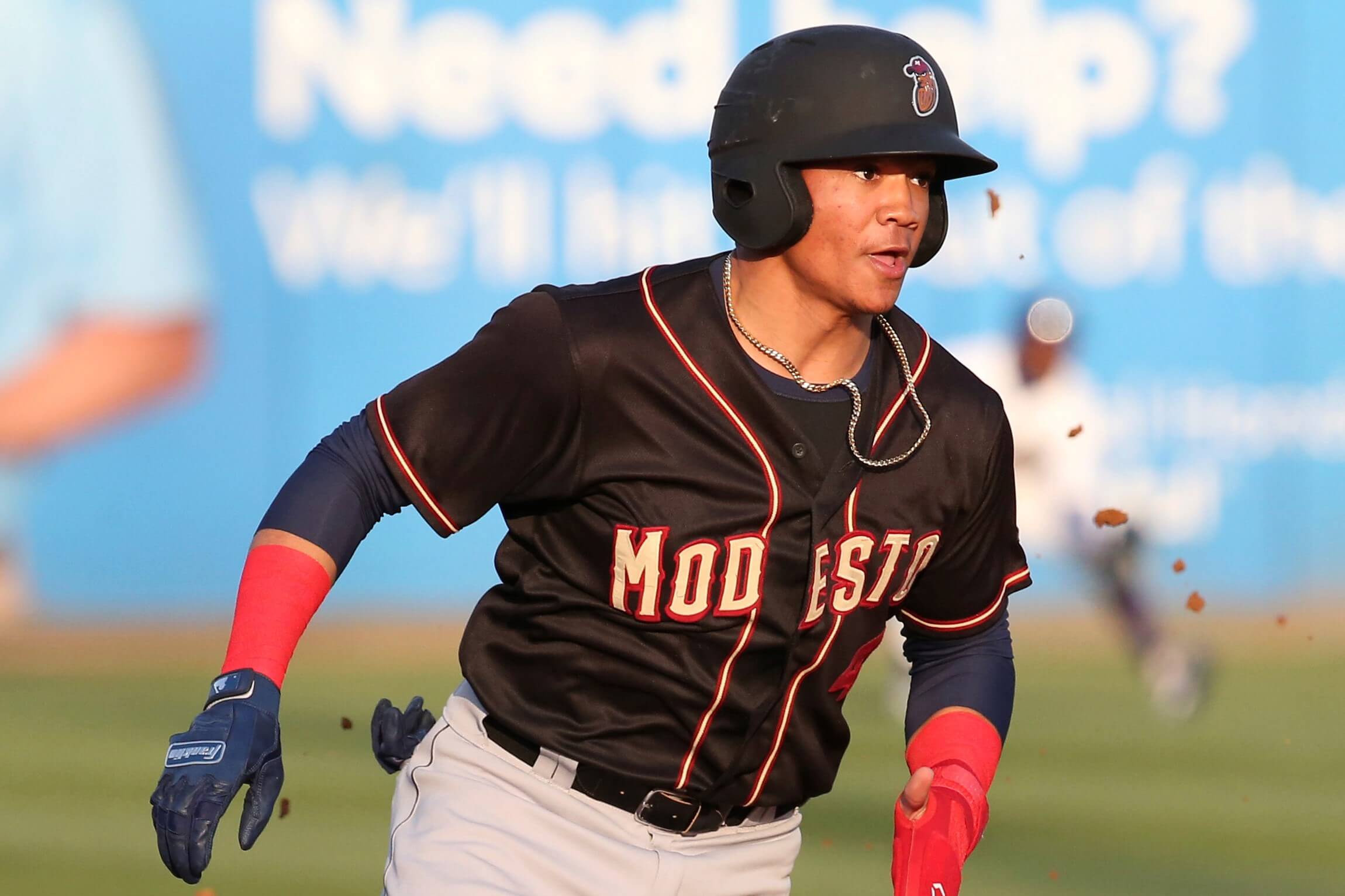
Noelvi Marte runs the bases with the Modesto Nuts last season. (Larry Goren / Four Seam Images via Associated Press)
The Mariners sure paid a premium for that insurance, though. They traded the two best prospects still in their system, plus another solid prospect and a minor-league reliever, for a year and a third of Castillo. Shortstop Noelvi Marte, who is No. 12 on my midseason prospect rankings, moved up to the top spot on the org list after Julio Rodríguez graduated. Marte got off to a slow start in High A this year but has been raking for about two months now, making more contact, hitting for more power and getting on base, all of which are things he can do regularly. He’s more physically mature than the typical 20-year-old, and he might have lost a little speed since last year, which probably increases the odds that he moves off shortstop, probably to third base. He has good hands and a plus arm to stay there as long as he doesn’t slow down too much, but the OBP and power combination will play anywhere.
Edwin Arroyo is currently in the honorable mentions for my midseason top-60 rankings, as the Mariners’ second-round pick from last year has been one of the best hitters in the Low-A California League this year despite being its youngest regular. He’s hitting .316/.385/.514 with just a 22 percent strikeout rate, stealing 21 times in 25 attempts, all as an 18-year-old who is actually younger than the Mariners’ first-round pick from this year, Pennsylvania high school shortstop Cole Young. Arroyo projects to stay at shortstop, and with the way he’s showing contact and power already, he might end up in Noelvi’s territory as a potential star.
The Reds also gained two other pitchers in the deal. Right-hander Levi Stoudt is a starter in Double A who works mostly fastball-changeup but has suffered for his lack of an average breaking ball, giving up a .512 slugging percentage to right-handed batters. His stuff backed up some this year as well, and he can’t succeed with lower velocity. Right-handed reliever Andrew Moore, who is not that Andrew Moore (drafted by Seattle in 2015) but a different Andrew Moore (drafted by Seattle in 2021), is probably just an organizational arm in the end, a reliever in High A now who has walked too many guys but throws hard and has a solid enough changeup that might help him get to the majors.
The two bats coming back to Cincinnati could be difference-makers, with some risk in each case but more than enough upside to justify the move, and it feels like the Reds went for ceiling here rather than playing it safe. The Mariners didn’t necessarily need Castillo, but he was the best starter out there, and if he’s the addition who ends their playoff drought, I don’t think anyone will question the cost. The Reds do have to trade Tyler Mahle at this point — there is no reason to keep him when his value is only going to go down from here as he approaches free agency after next year, and with Frankie Montas just back from a shoulder injury, Mahle might be the best starter available.
(Photo of Luis Castillo: Brad Penner / USA Today)
!function(f,b,e,v,n,t,s)
{if(f.fbq)return;n=f.fbq=function(){n.callMethod?
n.callMethod.apply(n,arguments):n.queue.push(arguments)};
if(!f._fbq)f._fbq=n;n.push=n;n.loaded=!0;n.version=’2.0′;
n.queue=[];t=b.createElement(e);t.async=!0;
t.src=v;s=b.getElementsByTagName(e)[0];
s.parentNode.insertBefore(t,s)}(window, document,’script’,
‘https://connect.facebook.net/en_US/fbevents.js’);
fbq(‘dataProcessingOptions’, []);
fbq(‘init’, ‘207679059578897’);
fbq(‘track’, ‘PageView’); .
White Sox GM Rick Hahn discusses Trade Deadline
CHICAGO — White Sox general manager Rick Hahn was not about to talk about any specific player potentially holding interest for his team as the Aug. 2 Trade Deadline approaches.
That edict included players on other teams, of course, or even a player on the open market such as outfielder Michael Conforto. So, when Hahn met with the media Friday afternoon and was asked about a player of Juan Soto’s excellence and expected high salary point to extend holding interest, he took a roundabout way of still making his point.
“How should I put this?” Hahn said. “I will say historically, as long I’ve been here working for [White Sox chairman] Jerry [Reinsdorf] and [executive vice president] Kenny [Williams], there hasn’t been a premium player that changed teams that we haven’t at least had a conversation about.
“You were probably, and this is my fault, we may have been a little too forthright or upfront in very recent premium free agent pursuits that led to fans being frustrated when we didn’t wind up converting on them. So I think at this point, I’m going to err on the side of that White Sox stealth mode … and if we make the deal, I’ll happily explain how it all came together.”
That premium free agent list would include third baseman Manny Machado, right-handed starter Zack Wheeler and outfielder Bryce Harper, players the White Sox pursued at some level over the past few years but eventually went elsewhere. Any team acquiring Soto, if the Nationals decide to move him, would have a little more than two years of control before he entered free agency.
All of this Soto talk is primarily hypothetical at this point. But Hahn did speak Friday about potential changes for a team entering the start of the second half trailing the Twins by three games in the American League Central. They were centered on areas of no surprise.
“Every team in baseball, whether they’re in it or not, never feels like they have enough pitching and we’re certainly not immune to that, primarily in the bullpen,” Hahn said. “Obviously, Aaron Bummer has been absent for a while. He’s starting to make some progress and we do project a return at some point, but that’s not guaranteed.
“So I would say bullpen’s probably the most obvious need. I think if you look at our offensive and defensive performance over the course of the year, the performances at second base and right field haven’t quite been what we would hope. That said, if you look at what Josh Harrison has done since June 1, and you look at what Gavin Sheets has done since he returned from the Minors, those both potentially could be solutions there. We’ll have to wait and see.”
The White Sox are a stronger offense against left-handed pitching, so a left-handed bat would help. Hahn wouldn’t even rule out a starting pitching addition, although the White Sox are pretty well set with Lucas Giolito, Dylan Cease, Johnny Cueto, Lance Lynn and Michael Kopech, even with Kopech’s workload being watched as the season progresses, and Hahn doesn’t see a great deal of volume in that market.
Hahn also won’t wait to make a move, gauging if a team currently in contention falls out in the next few weeks, if the deal makes sense and makes a difference.
“If we find the right deal for a player we think is impactful, we are going to want to pull the trigger on it when it’s available to us and not wait around,” Hahn said. “Take that bird in the hand vs. the two in the bush.
“With that said, it strikes me that more teams being in it, the added playoff spots, that a lot of these decisions might come down to the Deadline so teams know exactly where they sit. … The chatter has ramped up since Monday. I can’t tell you it’s because the Draft is over and we can only focus on one thing at a time as much as we’re within a couple weeks of the Deadline, so it’s only natural teams ramp up.”
.
Which players could move at the MLB trade deadline? One pick for all 30 teams
Baseball’s trade deadline looms in little more than a month. As far as trade targets, the usual suspects have already emerged. Consider the Nationals’ Josh Bell, who is in the midst of a career season just as teams begin zeroing in on impact bats. He is a veteran on an expiring deal — precisely the kind of player who is almost certainly going to be moved.
However, as The Athletic’s baseball experts identified one tradeable player from each of the 30 teams, a few focused on candidates who might not be so obvious. They include a former prospect who has lost some of his shine and a few good players who also come with plenty of team control.
Arizona Diamondbacks: Zach Davies
David Peralta may be the most obvious candidate, as he’s a notable name on an expiring deal, but his market could be muted. Teams are always looking for starting pitcher depth, however. Zach Davies is on a one-year, $1.75 million deal and has a 3.94 ERA in 15 starts. He’s pitched at least six innings in his last four starts. He’ll help a team survive into the postseason. — Zach Buchanan
Atlanta Braves: Kyle Muller
In about half of his 10 big-league outings, including nine starts, Kyle Muller has shown the potential to be a mid-rotation starter or better. He’s still a solid prospect though the hard-throwing 6-foot-7 lefty has fallen far behind young Braves starters Kyle Wright and rookie Spencer Strider. With Max Fried, Kyle Wright and Charlie Morton in the top three spots, and Mike Soroka expected back from a twice-torn Achilles in August, the Braves might have a surplus of starters. The 24-year-old Muller’s value could decrease if they keep him another year without a major league rotation spot. He’s made one MLB start this season and otherwise toiled in Triple A, where he has a 2.96 ERA with 99 strikeouts and 23 walks in 76 innings. — David O’Brien
Baltimore Orioles: Trey Mancini
Trey Mancini is 30 and a free agent at the end of the season, meaning he is not part of this rebuilding team’s future. He is a first base/DH type who can play the outfield in a pinch. But the Orioles are stacked in the outfield at the major- and minor-league levels and Ryan Mountcastle has settled in at first base. So, Mancini would be an expensive DH if the Orioles wanted to extend him, and there hasn’t been a lot of movement on that end. Still, he has a productive bat and is one of the most respected leaders/players in the game. — Dan Connolly
Boston Red Sox: Connor Seabold, Jarren Duran
Even in contention, it’s doubtful the Red Sox want to move any of their top-five-or-so prospects, but they’re suddenly deep in upper-level starting pitchers. They could dip into that redundancy at the deadline. Connor Seabold has been terrific in Triple A, but the Red Sox could move him — to bolster the bullpen, perhaps — without much risk of becoming short-handed. They could go bigger (Triston Casas, Brayan Bello, Jarren Duran) but for an organization that’s walking the line between present and future, someone like Seabold might be easier to dangle. Smaller immediate return, but also less long-term risk. — Chad Jennings
With Kiké Hernández on the injured list, Duran has been on a hot streak the last few weeks with the big-league club. He’s the type of player the Red Sox could flip for a back-end reliever the team could use down the stretch. Last year, chief baseball officer Chaim Bloom traded Michael Chavis to Pittsburgh in exchange for reliever Austin Davis so a similar move is certainly a possibility. — Jen McCaffrey
Chicago Cubs: David Roberston
The Cubs are obvious sellers and every player on an expiring deal is up for grabs. Closers are always hot commodities at the deadline and David Robertson is a veteran who has thrived in the heat of playoff races while in the biggest market in baseball. He is in the midst of a huge bounce-back season. For the second summer in a row, the Cubs will be moving arguably the best closer available at the deadline. As long as he stays healthy and productive, the Cubs are expecting a real strong return for him. — Sahadev Sharma
Chicago White Sox: Lenyn Sosa
The 22-year-old infielder has crushed Double-A pitching this season enough to earn his major league debut. But Lenyn Sosa is more of a player development triumph than the sort of tools monster for which the Sox tend to carve out long-term roles. As much as they need a second baseman now and in the future, they don’t seem quite ready to hand the position to Sosa in 2022 yet, and are light on near-major-league-ready pieces to shop around. This is dependent on the Sox rebounding as planned, in a season where nothing is going according to plan. A soft sell can’t be discounted if they’re going to keep losing home series to the Baltimore Orioles. — James Fegan
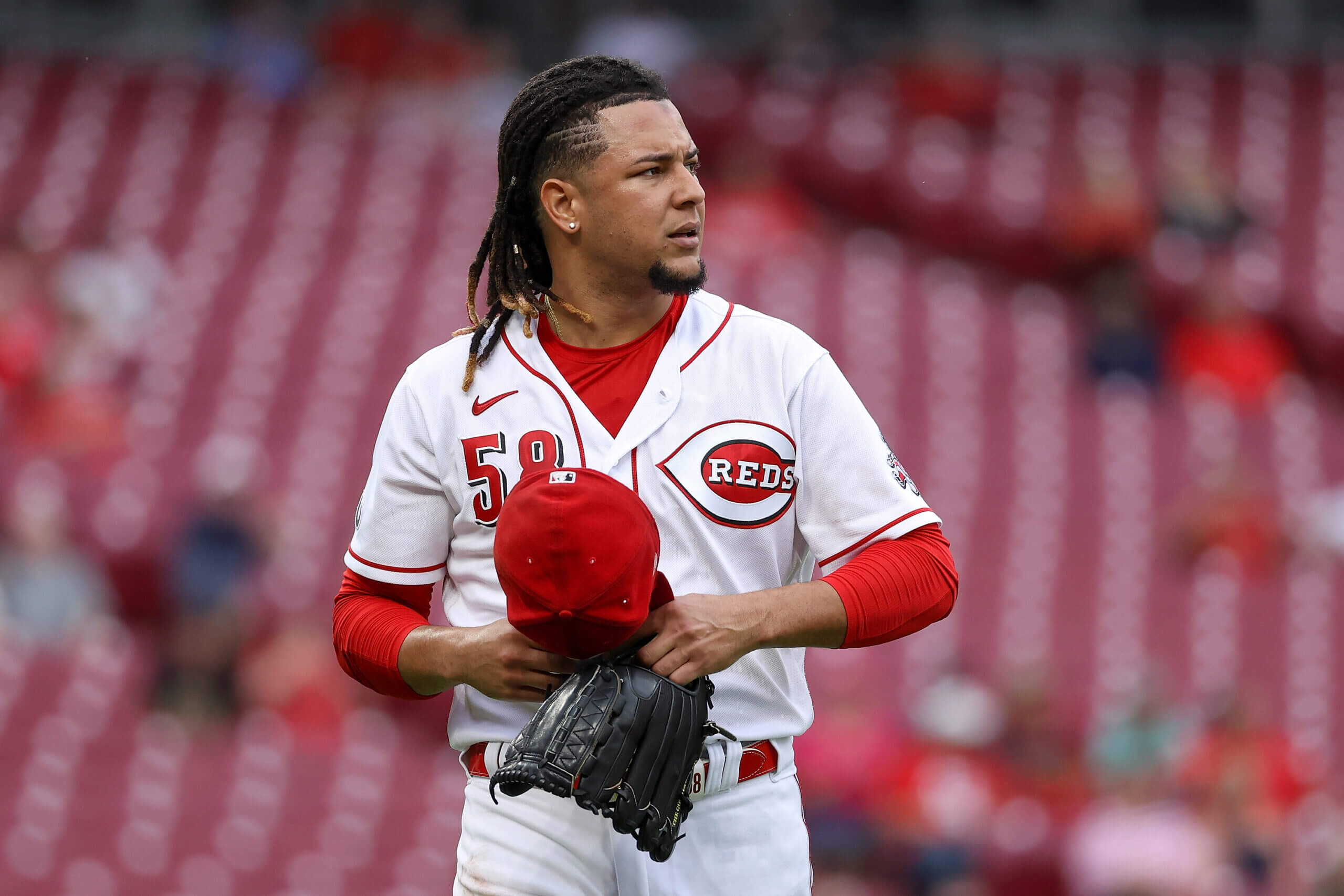
Luis Castillo. (Dylan Buell / Getty Images)
Cincinnati Reds: Luis Castillo
There will be no better starter on the trade market than Luis Castillo. The 29-year-old right-hander is under team control through the 2023 season but the Reds’ window doesn’t appear it’ll be open next year. While teams have been drooling over Castillo for years now, it seems this is the time to maximize the return. — C. Trent Rosecrans
Cleveland Guardians: Tyler Freeman
Tyler Freeman, if you’re reading this, don’t start packing your bags. I could have said Gabriel Arias or Brayan Rocchio or even Amed Rosario. There’s a well-documented logjam in the middle infield, and Andrés Giménez’s emergence this season might leave only one spot available. At some point, likely this summer or winter, the club will deal from its shortstop stockpile. Rosario probably won’t be a long-term member of Cleveland’s lineup, but it’s easier to envision him being dealt this winter, given his status both in the clubhouse and as the guy who hits just ahead of José Ramírez. — Zack Meisel
Colorado Rockies: José Iglesias
The veteran shortstop has played with six teams since 2018. His glove will travel. He was once a defensive wizard at the spot, and at 32, he’s now more reliable than highlight-ready. Still, José Iglesias’ instincts would play at both middle infield spots. At the plate, he makes a lot of contact, with a .298 average and a .346 OBP before this week’s games. And, oddly, he’s hitting much better outside of Coors Field than in it. The Red Sox added Iglesias late last season because they needed a proven defender to spark their lineup. It worked. The Rockies tried to duplicate that but they don’t really need him anymore. — Nick Groke
Detroit Tigers: Michael Fulmer
Michael Fulmer is in the final year of his contract, and the 2016 AL Rookie of the Year has turned into a powerful back-end reliever. He has a 2.00 ERA, a nasty slider and good metrics. The Tigers should be looking to move any bullpen pieces they can, and Fulmer is the most logical choice to be traded. — Cody Stavenhagen
Houston Astros: Chas McCormick
The Astros have a wealth of center fielders right now with the return of Jake Meyers, so Chas McCormick could be expendable at the deadline. The same goes for Jose Siri, Pedro Leon and Corey Julks. The Astros also have starting pitching depth, even more so when Lance McCullers Jr. returns. — Brittany Ghiroli
Kansas City Royals: Andrew Benintendi
Andrew Benintendi will become a free agent at the end of the season, so the Royals would be best served to move 2021’s Gold Glove-award-winning left fielder. Benintendi’s production at the plate has returned to the type of levels that made him a first-round pick. He’s only 27 years old and he’s currently batting .299 with a .367 on-base percentage. He also has the lowest strikeout rate of his career (14.2 percent). A team needing an impact bat will come calling, and considering the Royals’ lost season, a deal is imminent. — Alec Lewis
Los Angeles Angels: Jo Adell
The Angels are in a really tough spot. Not really in contention but assuredly not willing to punt on a season with a healthy Mike Trout and Shohei Ohtani. That being said, it’s hard to see them be true all-in buyers. The in-between and sensible answer here is Jo Adell. He’s been a top prospect who has now really struggled to live up to his potential. He’s gone up and down numerous times and just doesn’t seem to have a spot with the Angels. Maybe they can get a major-league-ready player back for him, as well. — Sam Blum
Los Angeles Dodgers: Ryan Pepiot
The Dodgers opted to keep Ryan Pepiot over top pitching prospect Josiah Gray in executing their blockbuster deal last year to bring Max Scherzer and Trea Turner to Los Angeles. It’s easy to see why they like him — that changeup has the potential to be one of the most devastating pitches in the sport. But he hasn’t yet flashed the consistent command in the strike zone to be a guarantee to help the Dodgers this October, and moving Pepiot might be their best path to getting what they need at the deadline. — Fabian Ardaya
Miami Marlins: Jesús Aguilar
The clock is ticking on Jesús Aguilar’s time in Miami. He’s a free agent this fall, making $7.5 million in 2022 and certain to not have his 2023 mutual option exercised. Unless the Marlins pull closer in the wild-card race soon, they’ll be better off with lefty Lewin Díaz and righty Garrett Cooper rather than flip-flopping between Aguilar and Cooper at first base and DH every day. Aguilar still has the pop and track record to intrigue a contending team as a bench bat, but Cooper is a cheaper option who has hit consistently, and Díaz deserves a real shot. — Stephen Nesbitt
Milwaukee Brewers: Weston Wilson
Weston Wilson is similar to a couple of the last prospects the Brewers traded (Cooper Hummel to Arizona in the Eduardo Escobar trade and Jamie Westbrook to Detroit for cash); he’s an older minor-leaguer with positional versatility who is probably ready to contribute to a major-league team. He has also improved over time. The Brewers may make a move to tweak their offense — not overhaul it — and Wilson is the kind of minor-leaguer (like Hummel), who can sometimes be involved in those kinds of exchanges. — Will Sammon
Minnesota Twins: Austin Martin
Austin Martin was the headline prospect acquired by the Twins in the José Berríos trade last July and they could look to swap him for a Berríos-like starter just one year later. Unfortunately, because Martin’s prospect stock has dipped during that time, it’s possible he would no longer be enough to bring back the caliber of starter the Twins need. In addition to Martin, the Twins also have an assortment of young major-league and upper-minors bats who could be packaged in a deal, like José Miranda, Spencer Steer, Matt Wallner, Trevor Larnach and Christian Encarnacion-Strand. Young hitters for a veteran pitcher who can help right now is seemingly the obvious move. — Aaron Gleeman
New York Mets: Dominic Smith
Trade rumors have rumbled about Dominic Smith since Pete Alonso’s emergence four years ago. The implementation of a universal DH in 2020 created a blueprint for what success could look like, especially with Smith smacking extra-base hits all over the field and earning down-ballot MVP votes as the Mets’ most prolific hitter in that shortened season. He hasn’t resembled that offensive force much since, and he’s fallen down the hierarchy for at-bats even with a DH again this season. Smith still has talent and team control, so there should be appeal elsewhere. It might be time for the Mets to find a different piece that fits their overall roster better. — Tim Britton
New York Yankees: Ken Waldichuk
Ken Waldichuk, a left-handed starter, has had a big rise in the Yankees’ system. During 2021’s trade deadline, the Yankees moved a handful of players who had added value in the previous year rather than move their top prospects. Waldichuk started the 2021 season in High A and was promoted to Triple A by late May 2022. Waldichuk has a high-carry fastball and has had success with the Yankees’ signature big-sweeping slider, leading him to a remarkably high strikeout rate. — Lindsey Adler
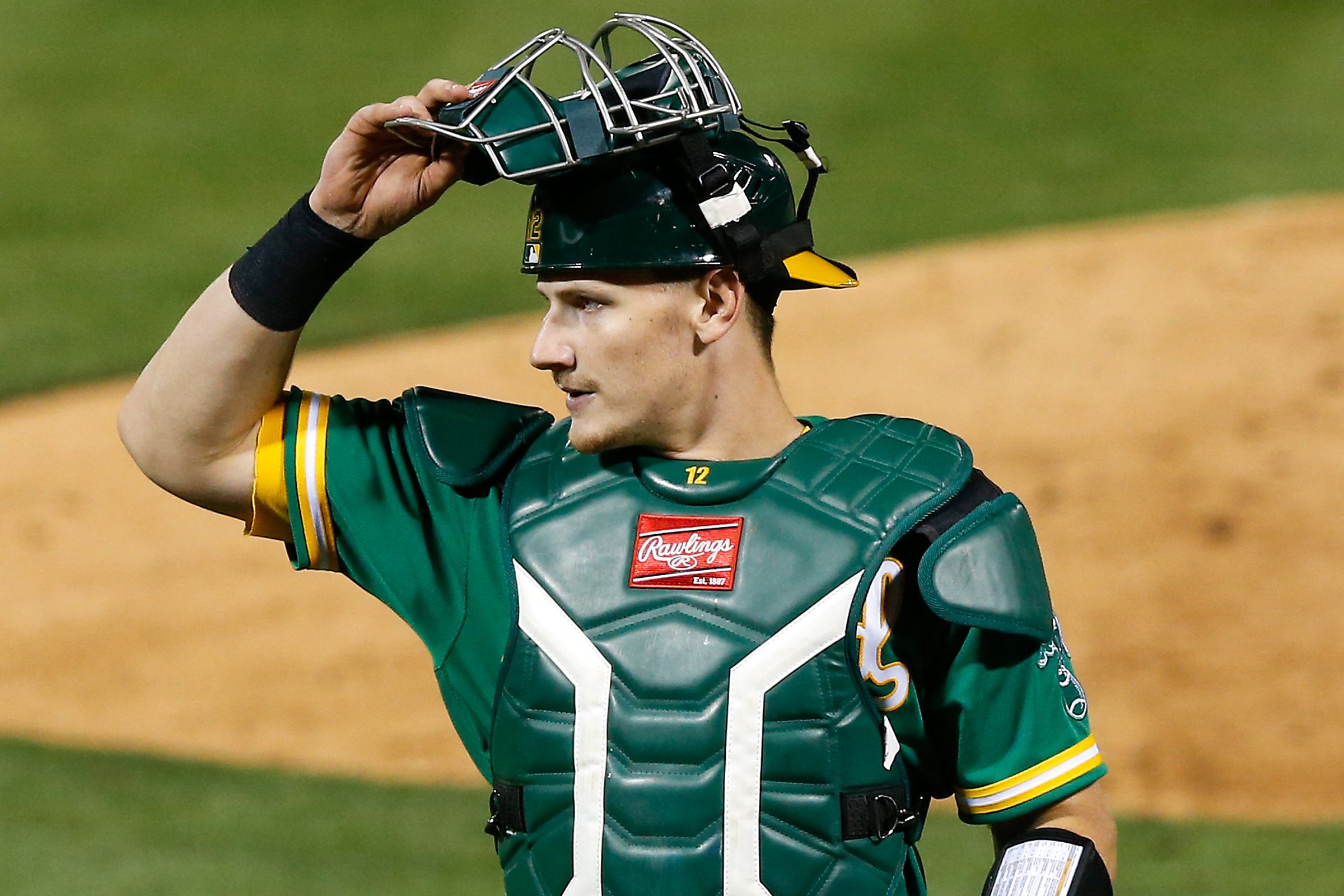
Sean Murphy. (Lachlan Cunningham / Getty Images)
Oakland Athletics: Sean Murphy
Frankie Montas will get the most attention because he’s the team’s biggest chip. But Sean Murphy could be an interesting player for teams in need of a starting catcher. He doesn’t hit for average, but he’s very good defensively with a plus arm and can hit the ball a long way. Murphy turns 28 in October and hits arbitration for the first time after the season. Jacob Stallings seems like a good comp; he lost his arbitration case with the Marlins and got $2.45 million after filing for $3.1 million. Murphy will probably get something in that neighborhood, which seems more than reasonable, but the A’s are pinching every penny. The A’s also have Shea Langeliers, the best player they received in the Matt Olson trade, in Triple A. His power numbers over the past two seasons should earn him a shot at a major-league starting job fairly soon. — Steve Berman
Philadelphia Phillies: Logan O’Hoppe
Teams don’t just trade good, young catching prospects on a whim, so it would take the right return — a big-league contributor under contract through at least 2023 — for the Phillies to entertain trading Logan O’Hoppe. He is 22 and he’s shown improvements in both plate discipline and power output. It’s a rare Phillies hitting development success — O’Hoppe was a 23rd-rounder who was not considered a top-tier prospect until a season ago. But the Phillies have a catcher, J.T. Realmuto, under contract through 2025. They don’t have a place to move him because they have numerous DH-types under contract through 2025 too. A team in a win-now mode like the Phillies will have to make tough decisions about how much of the future to sacrifice. This feels like a chance for them to sell high on a promising player who doesn’t have a path to contributing in the majors for the foreseeable future. — Matt Gelb
Pittsburgh Pirates: Kevin Newman
A Gold Glove finalist last year, Kevin Newman, 28, has missed most of this season with hamstring and groin injuries. He’s due to return to action soon, but top-100 prospect Oneil Cruz already has been called up to become the everyday shortstop. Newman could get some playing time at second base, but the Pirates have other better, younger players who are ready to fill that role. Still, Newman is a reliable defender who has a knack for collecting walk-off hits — two assets any contender can use. — Rob Biertempfel
San Diego Padres: Luis Campusano
Five years after they drafted him, the Padres remain reluctant to entrust Luis Campusano with their major-league pitching staff. They could use his power, but they seem relatively content with the Austin Nola-Jorge Alfaro duo at catcher and Luke Voit at designated hitter. With no obvious path to regular playing time, Campusano, 23, figures to resurface in trade rumors leading up to this year’s deadline. The Padres might hesitate to thin their catching depth, but they have previously dangled Campusano in front of other teams. And, in theory, his trade value has increased now that the DH is universal. — Dennis Lin
San Francisco Giants: Gregory Santos
There are few things as precious to a front office headed by Farhan Zaidi and Scott Harris as flexibility at the back end of a 40-man roster. They aggressively claim players and all of their arbitrage has led to unearthing some valuable pieces like Mike Yastrzemski and Luis Gonzalez. So all else being equal, the Giants prefer to trade players who require 40-man protection but aren’t part of the active major league group. That’s why it was so predictable that Alexander Canario, a Low-A outfielder, would be moved at the deadline last year. It’s why someone like Gregory Santos with his high-velocity fastball or High-A right-handed starting pitcher Randy Rodriguez could be good bets to be moved off the 40-man as part of a package this time. Flipping outfielder Heliot Ramos could help them stand out in trade talks as well. And they’d be quick to package someone like Double-A right-hander Kai-Wei Teng, who might otherwise be lost in the Rule 5 draft after the season. — Andrew Baggarly
Seattle Mariners: Chris Flexen
This might be a stretch, but if the Mariners believe minor league pitcher Taylor Dollard is ready to help the team, Seattle could dangle pitcher Chris Flexen before the trade deadline. If the Mariners want a bigger swing, they could move their top prospect, minor league shortstop Noelvi Marte, for a bat to help their offense. Maybe for Bryan Reynolds of the Pirates? — Corey Brock
St. Louis Cardinals: Alec Burleson
The Cardinals organization has done a considerable job in bolstering their overall depth. St. Louis has relied heavily on their rookie class this year and has shown little hesitance to promote those in Triple A like Nolan Gorman, Brendan Donovan and Juan Yepez, who have shown they are ready. Alec Burleson, an offensive-first outfielder who is hitting .343 with 15 homers and a .967 OPS for Triple-A Memphis, is showcasing that same readiness level. Yet with an outfield populated by Tyler O’Neill, Harrison Bader and Dylan Carlson, and Donovan and Yepez serving as reserves, there doesn’t seem to be a roster spot available for him. Burleson is a top-10 prospect. He has enough offensive upside for other organizations to be intrigued, and he could be a key name should the Cardinals decide to buy at the deadline. — Katie Woo
Tampa Bay Rays: Greg Jones
The Rays will be buying but don’t want to give up a top-10 prospect or anyone who could help soon. Greg Jones needs to be put on the 40-man next season, is 24 years old and in High A, and plays shortstop, which should be handled for the next few years by Wander Franco. Yeah, he strikes out a bit much, but he’s an athlete with power and patience at a premium position. He should net the Rays something. — Eno Sarris
Texas Rangers: Martín Pérez, Ezequiel Durán
If the Rangers sell, it probably makes sense to take advantage of Martín Pérez’s breakout year. He’s among the top 10 in ERA and bWAR for pitchers and has allowed the fewest homers per nine innings in baseball. He’s not a big strikeout guy, but if you’re not allowing runs, it doesn’t really matter how you’re getting the job done. If they go for it, Ezequiel Durán has already proven he can hit at the big-league level, and the Rangers have a glut of young infielders trying to grab the third base job in years to come, among them: Josh Smith, Josh Jung, Justin Foscue and Dustin Harris. Durán — the team’s No. 4 prospect per MLB.com — could be a good place to start a package. — Levi Weaver
Toronto Blue Jays: Spencer Horwitz
Spencer Horwitz had a breakout 2021 season, emerging as a sleeper prospect in Toronto’s system. He’s got a disciplined approach and hits from the left side. Through 63 games at Double A, the first baseman was hitting .289/.402/.490. Whether he can hit for enough power is a question, though he has eight home runs this season. The path to the Blue Jays as a first baseman isn’t an easy one. (For those who don’t follow the Jays much, Vladimir Guerrero Jr. plays first base). The Blue Jays need relief help and Horwitz could be the sort of mid-range prospect who fetches a rental arm. — Kaitlyn McGrath
Washington Nationals: Josh Bell
Josh Bell is in the midst of his best overall season, ranking among the best-hitting first basemen in the majors this year. He’s also on an affordable contract, so even though he would be a rental, upgrading to Bell’s bat at first base wouldn’t wreak havoc on finances. And a bonus: Bell has never played for a contender, so there might be a chance for the team that trades for him to sign him beyond 2022 if they have a future vacancy at the position and they’re perennially in the playoff hunt. — Maria Torres
(Top photo of Jo Adell: Kevin Jairaj / USA Today)
!function(f,b,e,v,n,t,s)
{if(f.fbq)return;n=f.fbq=function(){n.callMethod?
n.callMethod.apply(n,arguments):n.queue.push(arguments)};
if(!f._fbq)f._fbq=n;n.push=n;n.loaded=!0;n.version=’2.0′;
n.queue=[];t=b.createElement(e);t.async=!0;
t.src=v;s=b.getElementsByTagName(e)[0];
s.parentNode.insertBefore(t,s)}(window, document,’script’,
‘https://connect.facebook.net/en_US/fbevents.js’);
fbq(‘dataProcessingOptions’, []);
fbq(‘init’, ‘207679059578897’);
fbq(‘track’, ‘PageView’); .
Mariners’ first-base options after Ty France injury
ANAHEIM — Ty France landed on the 10-day injured list on Saturday with a left elbow sprain, a transaction that removed the most productive hitter in the Mariners’ already thin lineup for the immediate future.
France said he’ll use the next 3-4 days to rest and receive treatment, combat the inflammation then reevaluate. He may play some catch, but he won’t pick up a bat, as doctors and team athletic trainers informed him that swinging would present the most stress in the area.
“Not that they didn’t seem as concerned, but because it’s my non-throwing arm, I don’t think it’s as worrisome,” said France, who initially feared that he tore his UCL after sustaining the injury in a collision at first base on Thursday. “Basically, the biggest test is going to be swinging. If I can let go of the bat and hold on to it with that one hand with full strength, that will be when I’m cleared.”
France and the Mariners couldn’t guesstimate a timetable, and the earliest he can return is July 4 due to the move being retroactive to Friday. The club is already down its best power hitter, Mitch Haniger (Grade 2 high ankle sprain), and another key slugger, Kyle Lewis (concussion), making France’s absence loom even larger. The first baseman has made a strong push to earn his first All-Star bid, having slashed .316/.390/.476 (.866 OPS) with a team-high 2.3 Wins Above Replacement, per FanGraphs.
So, Seattle will press on — and here’s how that first base fill-in situation might look:
The internal options
Kevin Padlo made his second career start at first on Saturday, after Dylan Moore got the nod on Friday. Mariners manager Scott Servais also said that Abraham Toro and Luis Torrens could see action there, too. That foursome has a combined 31 games of experience at the position.
“I’m not quite sure how it’s all going to play out,” Servais said. “We’ll give a number of guys an opportunity — matchup-based, just keep rotating it through. I don’t think just finding one guy you’re going plop in there and say, ‘OK, you’re going to play every day until Ty gets back.’ That’s probably not the direction we’ll go in. We’ll mix it up.”
In a corresponding roster move, infielder Drew Ellis — who was claimed off waivers from Arizona on June 16 — was recalled from Triple-A Tacoma. Servais mentioned that Ellis could see time at first, though his only experience at the position is 28 games in the Minors. Ellis, a former second-round Draft pick, has just 34 games of big league experience.
Evan White will not factor into immediate playing time due to a setback with his hernia and hip injuries that halted his rehab assignment with Tacoma on June 14. The 2020 Gold Glove Award winner hasn’t played in the Majors since May 2021, and Servais mentioned that he’ll need prolonged playing time in the Minors once he’s healthy enough before he’s ready to return.
The external options
If those options sound limited, the trade market is just as barren currently — and the Aug. 2 Trade Deadline is far enough off that any transactions this early, with many teams still in the playoff hunt, will likely cost a premium.
The most notable impact option is switch-hitting Josh Bell, who is slashing .303/.386/.487 (.873 OPS) with 11 homers and 141 wRC+ (league average is 100) for the last-place Nationals. His defensive metrics have improved notably over the past two seasons, too, as he ranks in the 66th percentile this year in Outs Above Average. He’s almost certainly going to get moved in the next few weeks, but he’s also going to be a free agent in the offseason and would cost premium prospect capital.
The Mariners aren’t as deep as when their farm system was ranked No. 2 by MLB Pipeline in March, after graduating Julio Rodríguez and George Kirby, and sending starting pitcher Brandon Williamson to the Reds in the trade that returned Jesse Winker and Eugenio Suárez. They’ve also paused in dealing from that depth, especially for a rental.
Some fans have clamored for another Nationals slugger, former Mariner Nelson Cruz, but his inability to play first base makes that incredibly unlikely. Other first basemen who could become available include Baltimore’s Trey Mancini, Miami’s Jesús Aguilar and Garrett Cooper, Kansas City’s Hunter Dozier, the Mets’ Dominic Smith and more. None are as impactful as France.
The ripple effect
Translation: For now, the Mariners will operate with what they have, which could feature even more matchup-dictated lineups.
On Saturday against Angels lefty Patrick Sandoval, Moore, who has an .850 OPS against lefties, started at second base over Adam Frazier, who has a .580 OPS against southpaws and is slashing .220/.292/.295 overall in what’s been a trying first season in Seattle. Toro switch-hits but is far better from the left side, Padlo’s splits are better against righties, and Ellis, against lefties. Torrens has been far more inconsistent after crushing lefties last year.
Servais had already used 54 lineups in 72 games entering Friday, and with France out, he’ll continue to mix things up.
.

